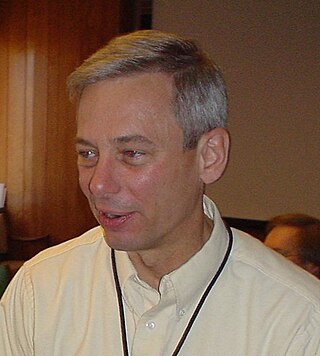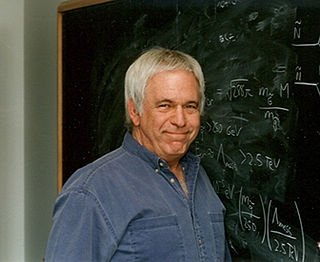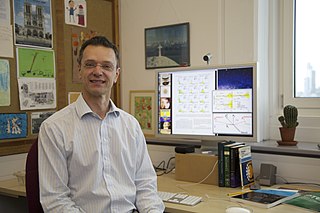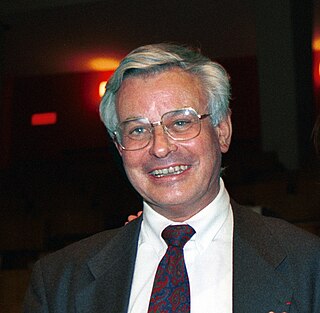
A gluon is a type of massless elementary particle that mediates the strong interaction between quarks, acting as the exchange particle for the interaction. Gluons are massless vector bosons, thereby having a spin of 1. Through the strong interaction, gluons bind quarks into groups according to quantum chromodynamics (QCD), forming hadrons such as protons and neutrons.
Hadronization is the process of the formation of hadrons out of quarks and gluons. There are two main branches of hadronization: quark-gluon plasma (QGP) transformation and colour string decay into hadrons. The transformation of quark-gluon plasma into hadrons is studied in lattice QCD numerical simulations, which are explored in relativistic heavy-ion experiments. Quark-gluon plasma hadronization occurred shortly after the Big Bang when the quark–gluon plasma cooled down to the Hagedorn temperature when free quarks and gluons cannot exist. In string breaking new hadrons are forming out of quarks, antiquarks and sometimes gluons, spontaneously created from the vacuum.

Two-photon physics, also called gamma–gamma physics, is a branch of particle physics that describes the interactions between two photons. Normally, beams of light pass through each other unperturbed. Inside an optical material, and if the intensity of the beams is high enough, the beams may affect each other through a variety of non-linear effects. In pure vacuum, some weak scattering of light by light exists as well. Also, above some threshold of this center-of-mass energy of the system of the two photons, matter can be created.

Dimitri V. Nanopoulos is a Greek physicist. He is one of the most regularly cited researchers in the world, cited more than 48,500 times across a number of separate branches of science.
Igor R. Klebanov is an American theoretical physicist. Since 1989, he has been a faculty member at Princeton University where he is currently a Eugene Higgins Professor of Physics and the director of the Princeton Center for Theoretical Science. In 2016, he was elected to the National Academy of Sciences. Since 2022, he is the director of the Simons Collaboration on Confinement and QCD Strings.

William Allen Zajc is a U.S. physicist and the I.I. Rabi Professor of Physics at Columbia University in New York, USA, where he has worked since 1987.
Delbrück scattering, the deflection of high-energy photons in the Coulomb field of nuclei as a consequence of vacuum polarization, was observed in 1975. The related process of the scattering of light by light, also a consequence of vacuum polarization, was not observed until 1998. In both cases, it is a process described by quantum electrodynamics.

John (Jean) Iliopoulos is a Greek physicist. He is the first person to present the Standard Model of particle physics in a single report. He is best known for his prediction of the charm quark with Sheldon Glashow and Luciano Maiani. Iliopoulos is also known for demonstrating the cancellation of anomalies in the Standard model. He is further known for the Fayet-Iliopoulos D-term formula, which was introduced in 1974. He is currently an honorary member of Laboratory of theoretical physics of École Normale Supérieure, Paris.

Quark–gluon plasma is an interacting localized assembly of quarks and gluons at thermal and chemical (abundance) equilibrium. The word plasma signals that free color charges are allowed. In a 1987 summary, Léon van Hove pointed out the equivalence of the three terms: quark gluon plasma, quark matter and a new state of matter. Since the temperature is above the Hagedorn temperature—and thus above the scale of light u,d-quark mass—the pressure exhibits the relativistic Stefan-Boltzmann format governed by temperature to the fourth power and many practically massless quark and gluon constituents. It can be said that QGP emerges to be the new phase of strongly interacting matter which manifests its physical properties in terms of nearly free dynamics of practically massless gluons and quarks. Both quarks and gluons must be present in conditions near chemical (yield) equilibrium with their colour charge open for a new state of matter to be referred to as QGP.
In astronomy, optics and particle physics, the Bose–Einstein correlations refer to correlations between identical bosons.
Hot spots in subatomic physics are regions of high energy density or temperature in hadronic or nuclear matter.

MoEDAL is a particle physics experiment at the Large Hadron Collider (LHC).

Gordon Leon Kane is Victor Weisskopf Distinguished University Professor at the University of Michigan and director emeritus at the Leinweber Center for Theoretical Physics (LCTP), a leading center for the advancement of theoretical physics. He was director of the LCTP from 2005 to 2011 and Victor Weisskopf Collegiate Professor of Physics from 2002 - 2011. He received the Lilienfeld Prize from the American Physical Society in 2012, and the J. J. Sakurai Prize for Theoretical Particle Physics in 2017.
In physical cosmology, warm inflation is one of two dynamical realizations of cosmological inflation. The other is the standard scenario, sometimes called cold inflation.

Kim Sun-kee is a South Korean physicist. He is professor in Seoul National University and director of the Korea Invisible Mass Search. He was the first director of the Rare Isotope Science Project within the Institute for Basic Science and is a member of the Korean Academy of Science and Technology.

Terence Richard Wyatt is a Professor in the School of Physics and Astronomy at the University of Manchester, UK.
Olga Evdokimov is a Russian born professor of physics at the University of Illinois, Chicago (UIC). She is a High Energy Nuclear Physicist, who currently collaborates on two international experiments; the Solenoidal Tracker At RHIC (STAR) experiment at the Relativistic Heavy Ion Collider (RHIC), Brookhaven National Laboratory, Upton, New York and the Compact Muon Solenoid (CMS) experiment at the LHC, CERN, Geneva, Switzerland.

Maurice René Michel Jacob was a French theoretical particle physicist.
Graciela Beatriz Gelmini is a theoretical physicist who specializes in astroparticle physics. She is a professor at the University of California, Los Angeles (UCLA), and became a fellow of the American Physical Society in 2004.
James Lewis Pinfold is a British-Canadian physicist, specializing in particle physics.











